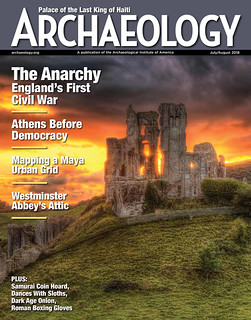
PREV ARTICLE
NEXT ARTICLE
FULL ISSUE
PREV FULL ISSUE
NOTES FROM E-SYLUM READERS: JULY 8, 2018 The Treasures of Paris Coins 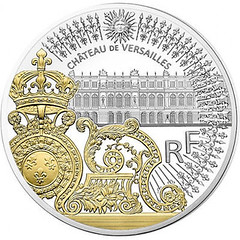
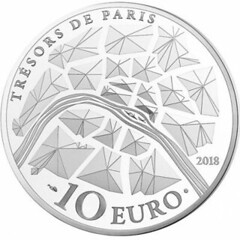
Last week I asked, "Can anyone tell us what the reverse design represents? The Monnaie de Paris product page I found doesn't say."
-Editor
Francois R. Velde writes: The reverse represents the city of Paris, crossed by the Seine river and divided into 20 arrondissements or wards (6 on the Left Bank or south of the river, 14 on the Right Bank), represented as little pyramids. The arrondissements are numbered in a clockwise spiral starting in the center. The series is called "Treasures of Paris" (broadly construed, apparently, since Versailles is outside city limits) and features monuments that feature gilding. The gate of Versailles, which had been dismantled at the Revolution, was rebuilt a few years ago as it stood at the time of Louis XIV. Other monuments in the series include the Palais Garnier (the opera house from 1875 to 1989), the Bastille column (erected on the site of the Bastille but commemorating another revolution, that of 1830), the Institut de France (a beautiful Baroque dome opposite the Louvre), and the Statue of Liberty (a small scale version of the famous one in New York harbor, cast by the artist and offered by the Americans of Paris to the city in 1889).
Thank you! See this week's In Other News article for an article on another Statue of Liberty lookalike.
-Editor
To read the earlier E-Sylum article, see:
Other London Corresponding Society Tokens
Last week I asked if anyone could provide images of other tokens issued by London Corresponding Society.
-Editor
Chris Bower of Indianapolis writes: I have a version of the one you used in your article. In addition to this more famous (infamous) one.
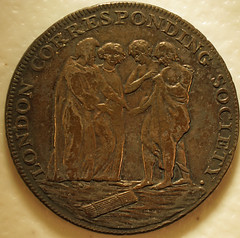
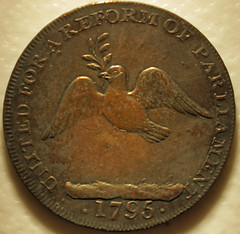
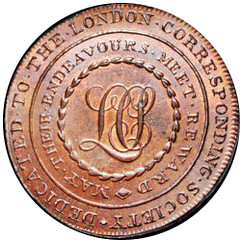
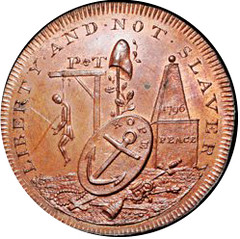
Thanks!
-Editor
To read the earlier E-Sylum article, see:
Chinese Sycee Bullion Pieces 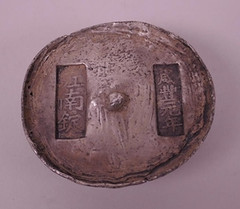
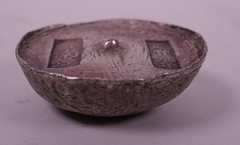
Howard A. Daniel III writes: The Chinese White Metal Trade Token is silver bullion and not a token. It could have been made by a business or a financial institution. There are many different shapes and all are called Sycee but each shape has a name too. There are MANY replicas being sold worldwide which originally came out of China. The "white metal" in the description could mean that it is not silver, which is often the case with the replicas. I have seen them cut in half and the core is copper or another metal and there is a thick plating of silver around it. Do not buy these pieces without the advice of a trusted and advanced collector or dealer. Ted Puls writes: The Chinese ingot shown appears to be a sycee from the reign of Hsien Feng, from the province of Jiangnan. The Mitchner volume on Non-Islamic oriental coins references similar "boat" sycee from Yunnan Province. J. Cribb has written a book on this I believe (but I don't possess it) that may have more detailed references. Many fakes exist. Ken Spindler of San Diego writes: That object is a Chinese sycee - an ingot produced privately for use in large commercial transactions and for paying taxes, from melted-down foreign silver coins, with a uniform appearance for the place and time, impressed with the names of the assayers and/or bankers who assured their purity. Sometimes they specified their function. There are lots of shapes and sizes, and they were made for hundreds of years. The vast majority of them trading between collectors today are from the 19th - early 20th centuries. They often appear in foreign-coin numismatic auctions, especially larger and older examples. There are probably several other references available to catalogue these with nowadays, but I used to do so for the auction house I worked for 10+ years ago using the British Museum's large volume covering their collection. I refer you to the article on sycee contained in 1801-1900 Standard Catalog of World Coins under China (at page 189 of my 8th edition), and oodles of them appear in (the must-have) Charles J. Opitz, An Ethnographic Study of Traditional Money.
Thanks, everyone.
-Editor
To read the earlier E-Sylum article, see:
Coin Hoards in English History
Thanks. I'm not a subscriber, and haven't seen this.
-Editor
For more information, see:
Hawaiian Statehood Special Medal Set I believe there is another special medal set that was created perhaps as a salesman sample set that included sample medals with different metals and finishes for the purpose of deciding what the medals should be made of. I have one medal of that set that appears to be made of copper or a copper finish. Other medals would have included silver plated and gold plated medals among others. I discussed this with Donald Medcalf (Gordon Medcalf's son). He was aware of the set. I do not know how many medals were in the set. Gordon Medcalf, Robert Fong, Donald Medcalf, and Ronald Russell wrote the 1967, 1978, and 1991 books on Hawaiian Money and Medals. With regard to the process set apparently only five complete sets were put together for the Gimbel store outlets as promotion items for the sale of the medals. They consisted of six medals including a blank planchet, 1st, 2nd, and third strikes; a trimmed medal (no finish), and a finished medal. (See Harmer, Rooke, Numismatists Ltd., The Andrew Faller Hawaiian Collection Treasure coins, March 26, 27, 28, 1975 page 13 Lot 257.)
Thanks!
-Editor
To read the earlier E-Sylum article, see:
Penalty Shootout Coin Proposed A few years ago the Royal Mint issued a 50 p to explain the football offside rule. I suggest they do one about penalty shootouts. (You will only understand that if you are a football fan).
Great idea. Here's the coin and an article for those who haven't been following the World Cup.
-Editor

What. Just. Happened? England fans have never experienced the feeling of winning a World Cup penalty shootout but the positive vibes that have carried Gareth Southgate's team so far continued on Tuesday night. The Three Lions beat Colombia 4-3 in a shootout to reach the quarter-finals of Russia 2018.
To read the complete article, see:
To read the earlier E-Sylum article, see:

Wayne Homren, Editor The Numismatic Bibliomania Society is a non-profit organization promoting numismatic literature. See our web site at coinbooks.org. To submit items for publication in The E-Sylum, write to the Editor at this address: whomren@gmail.com To subscribe go to: https://my.binhost.com/lists/listinfo/esylum All Rights Reserved. NBS Home Page Contact the NBS webmaster 
|
